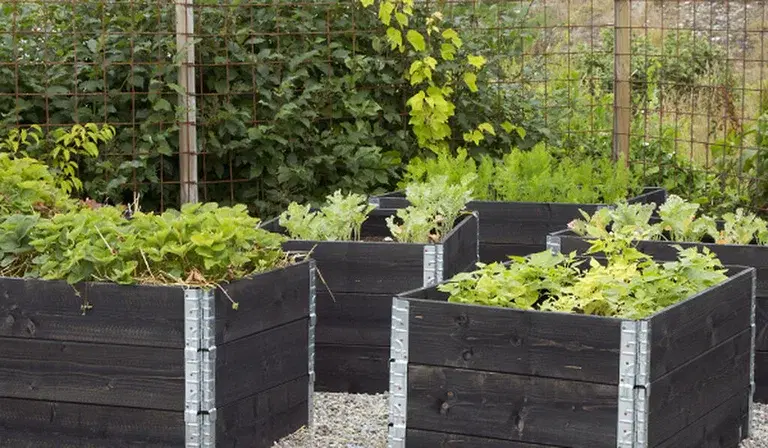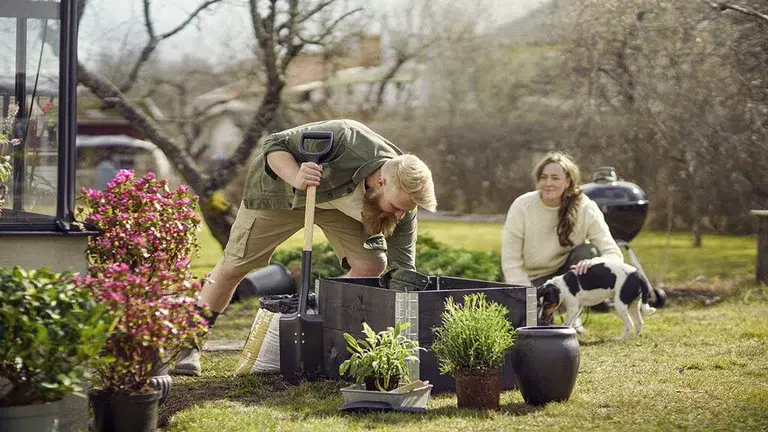Creating a kitchen garden – how to succeed
Organic tomatoes, large Jerusalem artichokes, or maybe crispy lettuce leaves? Many dream of going out into the garden and picking their own vegetables for dinner. But how do you actually build a kitchen garden? We give you the tips!

Growing your own vegetables provides benefits both in terms of taste and economy. Regardless of whether you grow a little on the balcony or aim to become self-sufficient, there is much to gain. In fact, no more than 800 square meters is needed to be able to provide a family of four with vegetables during a year.
Most vegetables are easy to grow, but of course, it can happen that a sowing fails from time to time, which can, for example, be due to bad luck with the weather, too old seeds, or the wrong type of soil. Remember the following three tips, and you will increase the chance of a good harvest:
- Soil – Most vegetables want deep, nutrient-rich, well-draining, and loose soil. Some plants, mainly herbs, may, however, prefer leaner soil. Read about what kind of soil the specific vegetable wants before you plant.
- Sun – The majority of vegetables love sun. Place the vegetable garden and the plants in a sunny place (at least 6 hours of full sun per day) and preferably also in shelter.
- Water and nutrients – Give water and fertilizer to the vegetables regularly, but avoid or be careful with fertilization in the beginning when the plants are small. Read about the nutrient needs of the specific vegetable you plan to grow. A pumpkin, for example, may need a lot of nutrients, while potatoes want more nutrient-poor soil.

What should the kitchen garden look like?
Just as you wish! You can grow directly in the soil, in pots, or in planting boxes. If you have limited space, growing on trellises and other vertical cultivation can provide extra space. Raised beds above the ground get warmer a little earlier in the spring and are often easy to drain. If you grow in pots, it is an advantage if they are sturdy and have drainage holes.
A garden is best experienced with some defined areas. Vegetables can be used to make the whole more inviting, for example, tall Jerusalem artichokes can be used as a hedge against the neighbor or berry bushes as a frame for the gazebo. Also, think about planning a garden path or two, so you can more easily walk around in the kitchen garden and care for the plants.

Good soil is half the job
Without good soil, it is almost impossible to get a good harvest. You can buy soil that is intended for the vegetables you choose, or make your own soil, for example, by mulching – that is, regularly laying thick layers of organic material around the plants. During decomposition, the material releases nutrients that reduce the need for fertilizer.
Buying soil, however, is a simple solution, and you can grow in the soil right away, and the soil is easy to handle. As a rule, you must add fertilizer during the growing season, for example, with compost.

Placement of the plants
The vegetable garden should be placed in a relatively flat, well-drained location in a sunny position – preferably a little away from trees and bushes, so that the plants do not have to compete for water and nutrients.
What vegetables should be grown?
Grow exactly what you want, but make sure the plants are hardy in your growing area and get the right conditions in terms of soil, fertilizer and sun.
When should it be cultivated?
All year round! In January, you can start with chili and verbena and later in the spring with potatoes, tomatoes, cucumber, and many other vegetables. Many vegetables must be pre-cultivated indoors before they are hardened and planted out. In late summer, an extra sowing of dill and spinach can have time to develop, and some seeds can also be sown in winter.
Spices and herbs
Herbs and spices are excellent additions to any kitchen garden. They usually require a lot of sun, and some want leaner soil. Frost-sensitive herbs can be brought in during the winter if you plant them in pots.

Greenhouses and growing tunnels
Greenhouses and growing tunnels extend the season. If you have the opportunity, it's worth investing in larger models. They provide better ventilation – and not least, more space.

Swedish garden inspirer, journalist and author of books about nature, cultivation and animals, such as "Soil", "Grow for insects" and "Chickens as a hobby".
Read more:
You are here:











